WorldShare Acquisitions Release Notes, April 2022
Release Date: April 28, 2022
Introducción
This release of WorldShare Acquisitions provides new features and enhancements in addition to numerous bug fixes. These features will help you manage more complex workflows, including:
- Enable accrual mode for subscriptions that span multiple budget periods
- View warning when placing order for subscription items not in accrual mode
- Pre-fill call number based on previous received copies for order item with multiple copies
- Mark historical issues as received when receiving new issues
- View new To Be Expended and To be Pre-Paid columns on invoice
Many of these enhancements are the direct result of your feedback.
Recommended actions
For this release, we recommend that you review the following checklists and complete the relevant tasks so that you can adjust your policies and workflows and train your staff. These checklists identify updates that we have determined as significant for most institutions. We encourage you to review all of the items in the release notes to determine whether there are other items that might require additional action or follow-up by your institution.
Administrative actions
These items require immediate action or decisions.
| Acción |
|---|
|
None at this time. |
Follow-up actions
In an effort to keep your staff informed of new features and changes, you may also want to consider these items.
| Acción |
|---|
|
Investigate whether you want to use accrual mode for some of your subscriptions that span multiple budget periods. |
New features and enhancements
Enable accrual mode for subscriptions that span multiple budget periods
You can now enable accrual mode for subscriptions. This will automatically split the cost of the item over multiple budget periods based on the number of days that the subscription falls within that budget period. For example, if you have a subscription that costs 1,000.00 USD and runs from January 1- December 31, 2022, and you have a budget period that runs from July 1 - June 30, 2022, the subscription will encumber or expend 49.58% or $495.80 in the current budget period (181 days out of 365 = .4958). The remaining encumbrance or expenditure will be applied to the next budget period once the current budget period is closed. The portion of the subscription that falls within the current budget period will be expended in the current budget period, and the portion that falls within the next budget period will be expended in the next budget period. Previously, to split the cost of a subscription between budget periods, you needed to calculate the percentage yourself and assign the correct percentage to the different budget periods. Additionally, you needed to have both budget periods enabled for use. Now, you can have the system automatically calculate the correct percentage to encumber or expend in the budget period, and you do not have to have both budget periods enabled to split it in this way.
To use accrual mode for an order item and invoice item:
- First add an item to an order. Select Acquisitions Type = Subscription and Processing Type = Serial, E-Product, or Local Resource.
- Accrual mode is only allowed for Subscription order items.
- Accrual mode is not allowed for the Processing Type of Monographic Series.
- Click on the item's title either from the order page (Orders > Orders > Click on order number) or the order item search (Orders > Order Items). Enter a start date and end date for the order item. (Accrual mode can only be enabled for subscription items with a start and end date). Make sure that the start date falls within or before an enabled budget period.
- Click on the Budget/Fund tab.
- Select the budget period that the start date falls within; if the start date falls before the current budget period, select the current budget period.
- At the top of the Budget/Fund tab, select the Enable Accrual Mode check box. If accrual mode cannot be enabled, the check box may be greyed out and a red message will appear below the accrual mode check box. As stated above, an accrual mode item:
- Must have Acquisitions Type set to Subscription
- Must have start and end dates
- Must have the budget period that the start date falls within (or before) selected
- Cannot be a Monographic Series.
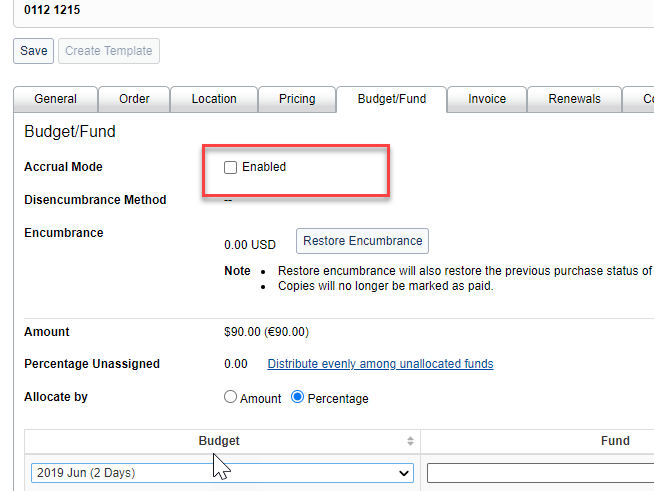
- A message will display that says, "When allocating money to funds using accrual mode, you must allocate the entire amount of the item to the [YYYY-YYY] budget period. Only the percentage of the amount which falls within that budget period will be encumbered upon ordering. The rest will be held aside and be encumbered when the [YYYY-YYY] budget is closed"
- Seleccione un fondo para el artículo de su pedido.
- Save your changes.
- Note that the Accrual Mode Encumbrances table displays at the bottom of the Budget/Fund tab. This table will display:
- The order amount.
- The amount encumbered in the selected budget period.
- The Future Encumbrance: the portion of the order amount not encumbered in the current budget period but reserved for the next budget period.
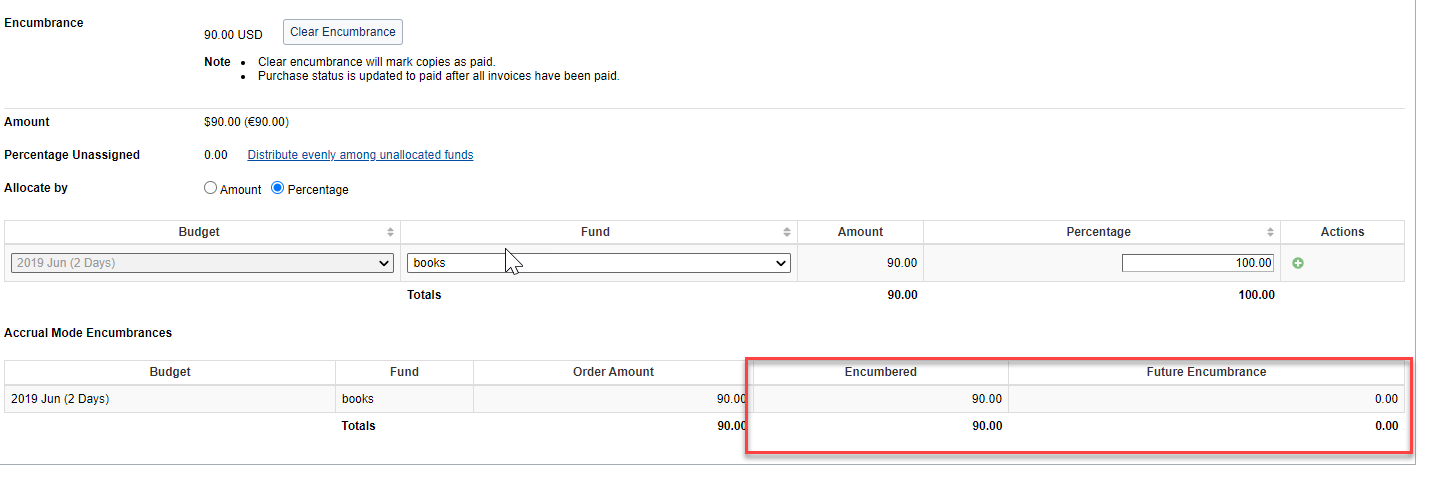
- Return to the order page and place the order.
- After placing the order, you cannot erase the start date and end date of the order item. If you attempt to do so, you will receive an error message and will not be able to save your changes to the order item until you re-enter the start date and end date values.
- You can then invoice the item. To do this, go to Receive and Invoice.
- Select the Processing Type of the item you ordered.
- Select Action Invoice.
- Click New Invoice.
- Enter the Invoice Number and the Vendor of the order. Create new invoice.
- Click View Items in the Receive and Invoice panel.
- Search for the item you ordered previously.
- Once you have found the item, click the Add to Invoice button next to the item.
- The Add Item to Invoice dialog will appear.
- A message will appear at the top of the dialog that says, "The order item being invoiced uses accrual mode. Only full invoicing is currently allowed for accrual mode order items. To allow invoicing by percentage or amount, disable accrual mode for the order item." (As stated, only full 100% invoicing is possible for accrual mode order items.)
- Click Add.
- Click on Invoice Number in the bottom right corner of the screen.
- Click on "Assign multiple budgets/funds" for the invoice item.
- Within the resulting dialog, you will see that the invoice item is also in accrual mode. (All invoice items for an accrual mode order item must also be using accrual mode.) Additionally, at the bottom of the dialog, you will see an Accrual Mode Expenditures table that shows the amount Expended and the amount Pre-Paid, that is to be expended in the next budget period upon the close of the budget.

- If you open the budget itself, you will see Future Encumbrances and Pre-Paid Expenses added to the summary table at the top of the budget page.
Note: The total amount of Future Encumbrance or Pre-Paid Expenses for all funds on the budget are listed here, but they are not included in the pie chart on this page.
Note: There is currently a bug where the Future Encumbrance is sometimes not calculated correctly. Please see the Known Issues below
- You can enable two new columns on the budget page. Using the gear icon, you can enable the Future Encumbrance and Pre-Paid Expenses columns.
Note: These columns do not add or subtract from the Remaining Balance of the fund. They are for informational purposes only. The Future Encumbrance, if not paid before closing the budget, will become an Encumbrance in the next budget period(s). The Pre-Paid Expenses will become expenditures in future budget period(s) upon closing of the budget period.
- You can search for order items and invoice items that use accrual mode. To do this, go to the order item search or invoice item search and select Accrual Mode from the Filters. From the filter, select Yes to see all items using accrual mode.
- When you close the budget, the funds used to encumber or expend monies for accrual mode items will appear in the close budget dialog. Once you have mapped these funds to a fund in the next budget period and closed the budget, the monies will be encumbered or expended on the new fund in the now current budget period. (Therefore, you should take care to select the correct fund when closing the budget.)
- If you export an invoice using the WMS Accounting System Invoice Connector, and then you import the payment data for the invoice, you can at this time import a different payment amount for each invoice item. If you do this for an accrual mode item, the system will automatically divide the new amount of the invoice item between the two budget periods proportionally based on the number of days that fall within each budget period.
View warning when placing order for subscription items not in accrual mode
You can now configure the system to display a warning when placing an order for a subscription item that is above a user-specified price threshold and that is not using accrual mode. Some libraries are required to use accrual mode for all subscription items above a certain price. For these libraries, they want to be warned when they are placing orders for subscription items above this threshold that are not using accrual mode. Now, they can set a threshold and be warned when placing an order that one of their items is a subscription, is above the threshold, and is not using accrual mode.
To view this warning:
- Go to Settings > Administration > Optional Features.
- For the Accrual Mode Threshold, enter a positive value or amount. (Leaving it blank will mean the system will never display a warning.)
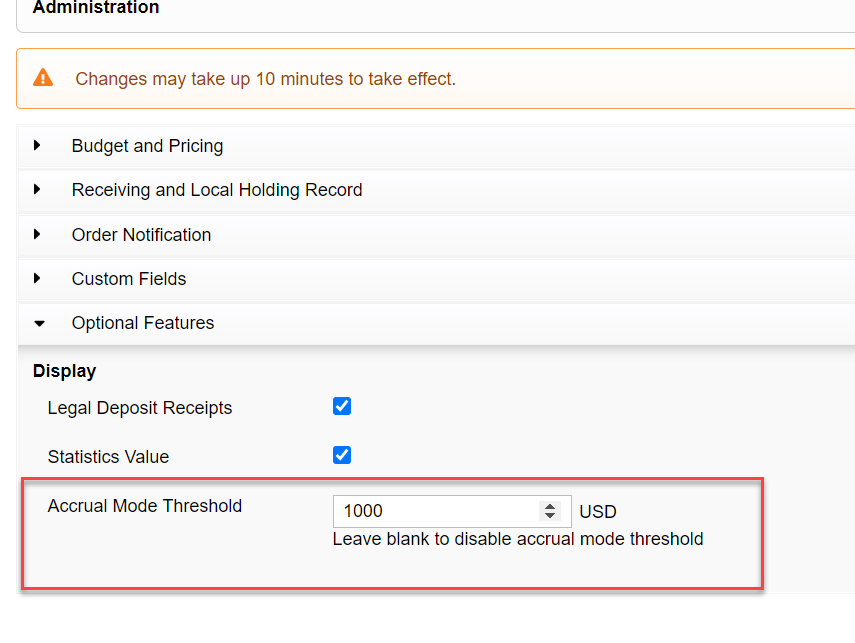
- Wait 10 minutes for changes to take effect.
- Create a subscription order item that has a price above the threshold you entered in step 2.
- Place the order for this item.
- A Place Order confirmation dialog will appear. In it a warning will appear that says, "Some items on this order are above the accrual mode threshold of 1000.00 but are not in accrual mode. You may want to cancel placing this order and enable accrual mode for these items."
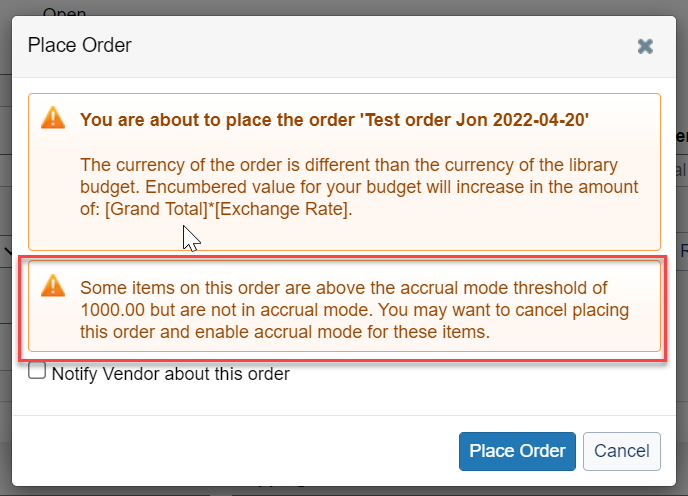
- You can ignore this warning and still place the order, if you wish.
Pre-fill call number based on previous received copies for order item with multiple copies
When receiving multiple monograph copies for the same order item, the user can choose to have the call number of subsequent copies pre-filled with the call number from previous received copies of the same order item. This saves time in entering the same chosen call number for multiple copies of the same order item and allows you to make sure all the copies have the same call number. Previously, the call number was pre-filled only with the call number from the bibliographic record in WorldCat. This was useful for the first copy (and still works this way for initial copies), but not as useful for subsequent copies of the same order item.
To pre-fill call numbers based on previous copies of the order item received:
- Go to Settings > Administration > Receive and expand the Local Holding Record accordion.
- Select "Use most recent call number for additional copies of order item."
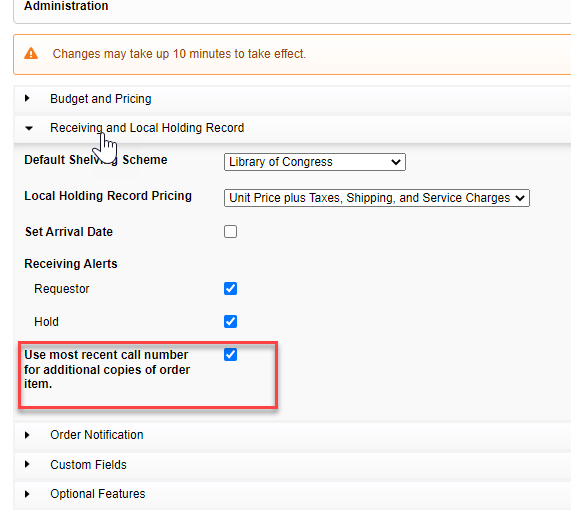
- Click on Receive and Invoice in the left-hand panel.
- Select Processing Type: Monograph and Action: Receive.
- Click View Items.
- Using the search box, search for an order item with multiple copies.
- Note that when opening the copies for the first time (before receiving any) the pre-filled call number for the copies comes from the bibliographic record.
- Modify the call number of the first copy. At the end of the call number enter c. 1 for copy 1.
- Receive the first copy (with the modified call number) by entering a barcode into the barcode field and pressing enter.
- The remaining copies will be refreshed and the call number pre-filled with the call number just entered for the first copy, including the c. 1 at the end.
- Modify the call number (e.g. change c. 1 to c. 2) and receive the second copy.
- The remaining copies will be refreshed and the call number pre-filled with the call number just entered for the second copy (including c. 2 at the end).
Mark historical issues as received when receiving new issues
When receiving an issue in serials management that also exists on an older merged OCLC Number, the issue on the old OCLC Number will also be marked as received. This way, it no longer continues to show up on the Missing Issues list to be claimed. Previously, when you received an issue that also existed on an older version of the WorldCat record that was merged into the current record, only the issue on the current OCLC Number was received. The issue on the previous OCLC number was left forever unreceived. If this issue showed up on the Missing Issues page, users had to remember to "Stop Claiming" this issue. Now, if you receive an issue with the identical enumeration and chronology as a historical issue (that is an issue on an older version of the same WorldCat record), the older issue will be received as well, automatically removing it from the Missing Issues list.
To use this functionality, simply receive issues as normal. If an issue exists under the Historical Issues tab with the matching enumeration and chronology, it will be marked as received by the system, although no holding will be created on the Local Holding Record. If the issue is on the Missing Issues list, it will be removed when all expected issues are received.
View new To Be Expended and To be Pre-Paid columns on invoice
On the invoice page, you can now view the "To Be Expended" amount and "To Be Pre-Paid" amount for each invoice item. To do this, simply use the gear icon above the invoice item table to enable these two new columns. They will display the current amounts that will be either expended or pre-paid on the selected budget period. Previously, this information was not available except on the budget page itself. You can view this information on the invoice for all invoice items too.

Bug fixes
Serials automated claiming now working
Serial issue automated claiming jobs are now working. Previously, a user could only manually run a serial issue claiming automated job. The jobs would not run automatically on a schedule. Now, the jobs will run as scheduled. If you have not previously manually run the job, it will run after the release and all pending serial issues will be claimed at that time.
Updating multiple items on an invoice results in all items being shown
After updating multiple items on an invoice, the page will refresh and show all invoice items for that page. Previously, after updating multiple items on an invoice, only five items would display on the page, and the user had to refresh the page to show all the items that should have been appearing. This problem has been fixed and the appropriate number of items displays on the page after updating.
Prices in EDIFACT order include amount values
All prices in the EDIFACT order message sent to vendors now include a value. Previously, only the price of type AAF was provided. The other 3 price types were sent with an empty value, causing problems with vendor processing of the order. Now, all prices are sent in the EDIFACT order message.
Custom fields now display in add item to order screen
The Custom Fields for an item now display when adding an item to an order. Previously, when adding an item to an order using an order item template, the Custom Fields tab would not display in the Item Details accordion. Any custom fields from the template would still be applied to the new order item, but the user could not edit these custom fields before adding the item.
Known Issues
Future encumbrance is not calculated correctly for child funds
The Future Encumbrance in the Budget Summary section of the budget (top of page next to pie chart) does not display the correct amount if there are child funds with future encumbrances. We will fix this bug with the next release.
Pay and mark as ready buttons not displaying on imported invoices
If you import an invoice into WMS, the resulting invoice will not have the Pay or Mark as Ready buttons on it. You have to make a change to the invoice and save it, and the buttons will appear. We will fix this in an upcoming release.
Sorting invoice items by budget/fund on invoice
Sorting invoice items by budget/fund on the invoice page does not work temporarily. This was causing bad data to display on this page and had to be disabled while a fix could be created. We are evaluating options now for fixing this problem.
Important Links
Support website(s)
Support information for this product and related products can be found at:
